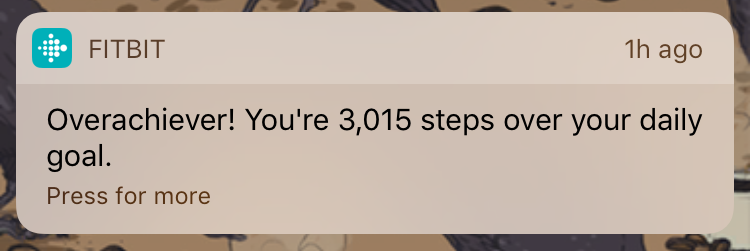This is a crosspost from Medium.
I bought a Fitbit a few weeks ago, thinking vaguely that it would help me walk more. Instead, I’ve experienced the opposite effect: my Fitbit helps me walk less. This is awesome. It’s also been a neat look at how technology assumes a lot about its users.
Some necessary background: I have a chronic illness; I’m partial to terms like spoonie and crip. My illness comes with a hefty dose of chronic pain and joint problems. I can walk, and I know that more walking is probably good for me. At the same time, some days are harder than others, and occasionally I’ll need a mobility aid.
So anyway. Fitbit.

It’s a household name at this point, right? You clip a tiny pedometer to yourself, set a goal, and it generates pretty graphs of your steps walked. The 10,000 steps a day recommendation is probably kinda bullshit in the specifics (studies using it as a benchmark are apparently inspired by a 1960s Japanese pedometer fad?). But the idea of increasing your daily activity sounds like a no-brainer.
Before I set any goals, I wore mine for a week to collect some baseline data. On days where I had been decently active, but didn’t feel like warmed-over shit by the end of it — days where I’d gone into the office, and then maybe one other place afterwards — my Fitbit informed me I’d walked about 8,000 steps. Sure, I said. Let’s set that as a target. Can I average 8k daily steps?
Except…then there were the days when I did feel like shit. Those days, I’d blown past 12,000 steps.
Oops.
…wait.
I re-set my goal to 12,000 steps. Then I spent a couple of weeks deliberately trying not to overextend myself by walking too far. Lo and behold: my life improved. I needed fewer recovery days. Thanks, Fitbit!
Fitbit sends you friendly encouragements when you’re about to hit your step goal. These are, it turns out, surprisingly useful for the inverse case — I treat them as warnings to stop what I’m doing and go take care of myself.

The most hilarious part of this is that Fitbit clearly is not designed to help me, or people like me. Take a look at this quiz, which is one of the first interactions you have with the Fitbit app:

“Exercise is fantastically painful and not actually my goal”, curiously, does not feature on the list. If you want to be generous, you could say that the first option works. But the entire app, the brand, and the marketing is still pushing me to do more; walk more; get more fit. The website includes copy that encourages you to push your limits and do more, more, more. Live better by being fit!
What happens when you’ll never be fit? What happens if you’re not able-bodied?

Last week I walked 15,000 steps in one day. I got home, tumbled into bed, and spent the next five hours lying spread-eagled and waiting for the pain meds to kick in.
Fitbit sent me a congratulatory message for being an “overachiever”.
To be clear: I like my Fitbit a lot. It has, indeed, helped me achieve my “fitness goals”. Just…not in the way that the company imagined. Every piece of copy, every cheerful badge, every reference to running marathons or climbing mountains, serves as a reminder that I am not the user this product was intended for.
I don’t actually expect Fitbit to have a spoonie mode. It runs against too much of their branding. But still: disabled folks exist. Sick folks exist. We use your shit, too. It’s possible to make more inclusive fitness software.
Think about it, sometime.

